The Rules of Halma
Halma is a famous old Victorian game in which the objective is not to capture your opponent's pieces but instead to hop over them in an effort to get to the opposite side first. Similar to Chinese Checkers but with more depth and added complexity as there are 8 directions of movement instead of 6.
See also: Halma.
The Equipment
A Halma board consists of 16 x 16 small chequered squares. In each corner, a heavy line delineates 13 squares, which are the starting squares for pieces in the 4 player game. Two opposing corners additionally have another heavy line which delineates the 19 corner squares for the initial position of the pieces in the 2 player game. Pieces are usually flat disks like draughtsmen or upright like the classic pawn in chess. They come in four different colours.
The Preparation
Halma can be played by 2 or 4 players. When 2 players play, 19 pieces are positioned in the appropriate opposing corners in formation 1 - 2 - 3 - 4 - 5 - 4; when 4 players play, 13 pieces are positioned in each corner in formation 1 - 2 - 3 - 4 - 3.
The Objective
The aim of the game is to be the first to player to move all pieces across the board and into opposing corner, within area delineated by the heavy line. Should one or more of the squares in the target area contain a piece belonging to another player, this does not prevent a player from winning. In this case, the game is won when all the available points within the area are occupied.
The Play
A toss of a coin decides who starts. Players take turns to move a single piece of their own colour. The piece may either be simply moved into an adjacent square OR it may make one or more hops over other pieces. Where a hopping move is made, each hop must be over an adjacent piece and into the vacant square directly beyond it. A hop may be over any coloured piece including the player's own and can proceed in any one of the eight directions. After each hop, the player may either finish or, if possible and desired, continue by hopping over another piece. It does occasionally happen that a player is able to move a piece all the way from the starting corner across the board and into the opposite corner in one turn! Pieces are never removed from the board. It is permitted to move a piece into any square on the board including squares in areas belonging to other players. Once a piece has reached the opposite area, it may not be moved out of the area but it may move within the area.
Anti-Spoiling
Debate has always arisen over the situation where a player is prevented from winning because an opposing player's peg occupies one of the holes in the destination triangle. A number of anti-spoiling rules have been proposed - one work-around is to say that should one or more of the holes in the target triangle contain a peg belonging to another player, this does not prevent a player from winning. The game is simply won when all the available points within the triangle are occupied. Masters Games suggests the following additional rule invented by James Masters in 2002 which is wide enough to capture all such situations: If a player is prevented from winning because of the presence of an opposing peg in the destination area, the player is entitled to swap the opposing peg with that of his own peg. This applies for both a single hole move and any part of a hopping move.
Super Halma
! Halma can be speeded up and subjectively made more interesting by allowing 'long jumps'. In this variation called Super Halma, a piece may jump over a piece any number of empty spaces away, provided it can land the same number of empty spaces beyond it in a straight line. Put another way: A piece can jump a single other piece at any distance, provided that the jumped piece lies at the exact midpoint of the jump. The basic 'adjacent jump' allowed in the standard game is just the shortest form of a long jump. The inventor of Super Halma, Andrew Perkis, concluded that Super Halma was best played on a 10 x 10 board as a 2 player game with 19 pieces on each side.
These rules are provided by Masters Traditional Games, an Internet shop selling quality traditional games, pub games and unusual games. For general information or for copying and copyright, see our Rules Information page.
Our rules are comprehensive instructions for friendly play. If in doubt, always abide by locally-played or house rules.
Copyright James Masters, 2025. All rights reserved.


























